DNA Damage by Signaling
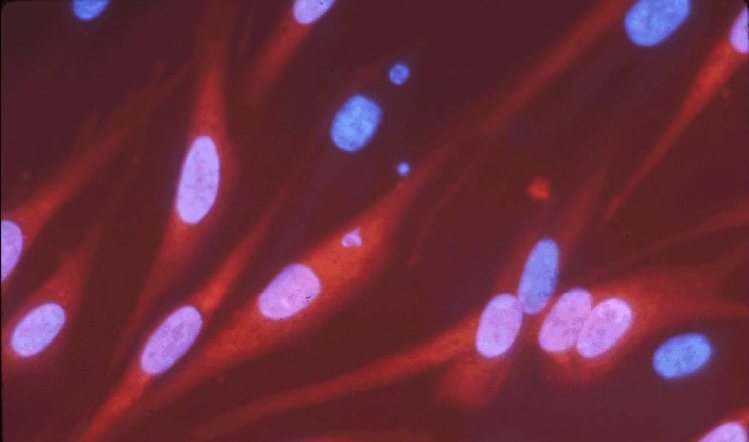
DNA damage by Signaling. Recently, QED induced radiation and the oxidative stress paradigm have been questioned by DNA damage thought by University of Bristol researchers to be caused by signaling damaged DNA across multi-layers of BeWo cells.
The signaling is similar to that for the standby effect depicted in the above figure. The pink cells were irradtiated with alpha particles and the blue cells were not. Damage of the pink cells is evidenced by the fragments. But the blue cells also become damaged. In traditionlal biology, the damage of blue cells is thought caused by signaling the damage from the pink cells.However, QED induced radiation from the pink cell fragments also could have fragmented the blue cells. More study is required to determine if the long thought signaling is in fact QED radiation.
In the Bristol research, the fragments were NPs of 30nm diameter CoCr while the barrier cells were grown on a 0.4 micron pore polyester filter supported on a Transwell insert, the insert positioned about 1 mm above the human fibroblast cells. The reduction in DNA damage by the CoCr NPs found upon adding drugs to the BeWo cells was claimed caused by the suppression of cell-to-cell communication in the junctions between cells. However, this is unlikely. The drugs included: apyrase an enzyme hydrolyzing ATP; allopurinol that inhibits xanthine oxidase; and connexin and pannexin channel blockers, all of which are UV absorptive evidenced by the fact they are detected in liquid chromatography by UV spectroscopy. What this means is the drugs are absorbing the QED induced radiation from the NPs, thereby reducing the corrosion of the CoCr NPs into Co and Cr ions and subsequent DNA damage from Co ions. See ScienceBlog and ASME Nanoengineering for Medicine and BIology Conference, NEMB 2010 Paper and Presentation
Cepheids by Cosmic Dust
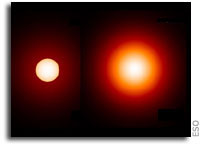
The Cepheid period-luminosity relation that stars with long periods are brighter than those with short periods including measurements of the distance to the star based on the Baade-Wesselink method are placed in question by cosmic dust. In the early 1900’s, the period-luminosity relationship of Cepheids was first reported by Henrietta Leavitt at the Harvard Observatory. Stars with longer periods were thought brighter than those with shorter-periods. Since the stars in the same distant clouds are about the same distance from the Earth, any difference in apparent magnitude was therefore thought related to a difference in absolute magnitude. Today, the Cepheid mechansim is thought caused by ionized helium. The problem is ionized helium is not opaque, at least not to red light. The Thumbnail above shows the dim part of the cycle to be clear and distinct with a faint red halo while the bright part is red-spotted and fuzzy. Neutral or ionized helium atoms should produce clear and distinct images for both dim and bright parts of the cycle. Only the lumpiness of the mass ejected from a Cepheid explosion would make the bright image spotted and fuzzy. In this regard, the Cepheids find similarity with the explosions of Supernova where the redshift of light emission is proportional to the mass ejected. See Science Blog and Press Release
Nanoscale Heat Transfer

Classically, heat is transferred by convection, radiation, and conduction. However, at the nanoscale classical heat transfer is restricted by quantum mechanics (QM) to vanishing specific heat. The QM restriction may be understood from the Einstein-Hopf relation for the harmonic oscillator that shows the heat capacity of an atom given by the average Planck energy at temperature is dispersed with wavelength. At room temperature, the full thermal kT energy of the oscillator rapidly vanishes below wavelengths of 50 microns, and therefore atoms in nanostructures lack heat capacity (specific heat) because the submicron NP size excludes all thermal wavelengths beyond a few microns. Electromagnetic (EM) energy absorbed by the nanostructure cannot be conserved by an increase in temperature.
Today, the heat transfer of nanostructures which are unambiguously not periodic continues to proceed on the erroneous assumption of macroscopic specific heat. See figure for heat flow in a CNT. In effect, the Dulong-Petit law of constant specific heat with temperature is implicitly extended from the macro to the nanoscale. Molecular dynamics (MD) simulations of nanostructures are proudly displayed on the belief they provide precise atomistic explanations of conduction heat transfer when in fact they are not valid because the simulations are performed assuming the atoms have full kT energy.
In this paper, heat transfer at the nanoscale explicitly assumes the material of the nanostructure has vanishing specific heat. Both the Debye model of specific heat based on phonon vibrations of atoms in a lattice and Einstein’s specific heat model of independent vibrations of the atoms as harmonic oscillators are only applicable to macroscopic structures having slow heat transfer processes that cannot respond in nanostructures at optical frequencies. The harmonic oscillator in Einstein’s atomic vibration model for specific heat is modified to represent photons consistent with Planck’s theory for blackbody radiation in an evacuated cavity, except the cavity is now a nanostructure of a solid medium having a finite refractive index. See Abstract , Paper ,and Presentation
Boiling Heat Transfer

Boiling heat transfer (BHT) relies on liquid to vapor phase change in the continuous production of bubbles to dissipate heat from a surface. But as the heat flux to the surface is increased, the production of bubbles ceases and an insulating vapor film forms that causes the surface to overheat to its detriment, the heat flux at which this occurs called the critical heat flux (CHF). Recently, nanofluids of water having less than 1% volume fractions of nanoparticles (NPs) have been shown to provide significant CHF enhancement over water alone, although the coefficient of BHT paradoxically is about the same. For heating by a wire, the bubble sizes are far larger for water with alumina NPs than for pure water as shown in the above figure. Classical heat transfer cannot explain this paradox, thereby allowing this quantum mechanics (QM) explanation. Atoms in NPs have thermal kT energy in the FIR. But NPs are submicron and by their size exclude FIR radiation, and therefore lack the heat capacity to conserve the absorption of heat by an increase in temperature. In the boiling process, the NPs repeatedly contact the heated surface. Momentarily, the NP becomes part of a macroscopic surface that by QM is allowed to have kT energy. But as the NPs come off the surface they are distinct submicron particles having excess kT energy not allowed by QM. Lacking specific heat, conservation proceeds by the QED induced frequency up-conversion of the excess kT energy in the FIR to the EM confinement frequency of the NP, the latter leaking to the surrounding water at VUV levels and beyond. By QED theory, the CHF-BHT paradox occurs because the NPs by emitting VUV avoid local thermal equilibrium (LTE) with the bubbles formed at the heated surface. The VUV emission from NPs therefore enhances the CHF by dissipating the heat flux to the surface without increasing the BHT coefficient. See Paper , ScienceBlog, and Press Release
Thermophones

Thermophones are thought to produce sound from vibrations by converting current at audio frequencies to rapid temperature changes. However, thermophones recently fabricated from nanoscale sheets of carbon nanotubes (CNTs) produce higher sound pressure levels (SPL) without vibration. Classical heat transfer cannot explain CNT thermophones, and instead quantum mechanics (QM) as embodied in the theory of QED induced EM radiation is proposed. QED stands for quantum electrodynamics and EM for electromagnetic. Atoms in CNT films having thickness < 0.2 microns are under EM confinement at levels beyond the ultraviolet (UV) that by QM have vanishing specific heat, and therefore Joule heat cannot be conserved by an increase in temperature. Conservation proceeds by the QED induced up-conversion of low frequency Joule heat to the UV confinement frequency of the film. Sound is produced from the pressure changes that accompany the absorption of UV emission by the surrounding air. See Paper and Press Release , See also Presentation , and ScienceBlog
Nanotrumpet Update
Recently, the journal Nature published an article entitled Nanotherm Trumpets that claimed sound was produced from temperature fluctuations in passing electrical current through an array of nanometer thick aluminum films.See Nature Article The claim is based on classical heat transfer theory that assumes films under Joule heating increase in temperature to heat the surrounding air and produce the pressure in propagating the sound. High thermal conductivity of the films is thought to allow the Joule heat to be lost to the substrate, and therefore not contribute to the large temperature fluctuations necessary to produce sound. To avoid loss of Joule heat, reductions in bulk thermal conductivity are viewed as an important feature of the Nanotrumpets. Required reductions in thin film thermal conductivity are supported by scattering of electrons in the Boltzmann transport equation (BTE).
QM trumps the classical heat transfer theory claims that Nanotrumpet sound is produced from temperature fluctuations in nanometer thick films. The validity of classical heat transfer theory in thin films having submicron thicknesses was the subject of an earlier critique of the BTE. See Thermophones Similarly, the Nanotrumpet claims are critiqued as unlikely. See Press Release and ScienceBlog
Solar Cells by Quantum Mechanics

In 1901, Nikola Tesla described the photoelectric effect in US patent “Apparatus for the Utilization of Radiant Energy.” Charging and discharging conductors was accomplished by using a metal plate exposed to ultraviolet (UV) radiation. Applied to solar cells, a polished insulated metal plate will gain a positive charge as electrons are ejected from the UV content in sunlight. As the plate charges positively, electrons are continually drained to a capacitor. In his patent, Tesla noted that as the radiation falls on the insulated metal plate, the capacitor will charge indefinitely. One of the Tesla's many US and Foreign patents is shown above.
Today, solar cells are generally not based on Tesla’s photoelectric effect that ejects electrons out of a metal plate from UV light. Instead, the photovoltaic (PV) effect is used where lower intensity visible (VIS) light only moves electrons out of the valence band of semiconductors into higher-energy conduction bands, thereby producing electric current at a voltage related to the band-gap energy. But thin film PV cells are usually limited to the VIS part of the solar spectrum. Infrared (IR) light with a wavelength between 0.7 and 300 microns cannot be utilized in PV cells by moving electrons between the valence and conduction bands, and certainly not eject electrons from metals by Tesla’s photoelectric effect. Nevertheless, IR light comprises a large fraction of sunlight that is lost in the PV conversion process. But quantum mechanics in submicron thin metal films allows the tull solar spectrum to converted to electricity. See Press Release and Science Blog
Nanocars by Quantum Mechanics
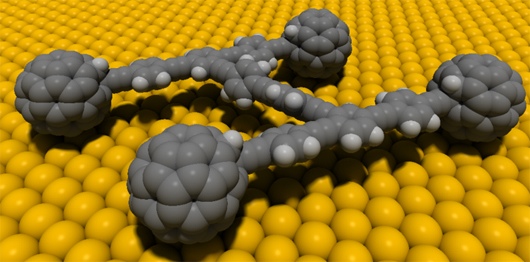
Nanocars including molecular motors convert EM energy into mechanical motion. Molecular dynamics (MD) simulations of heat transfer in nanocars are used to correlate temperatures to motion, but are invalid because QM restricts the thermal kT energy of the atom at the nanoscale. The QM restriction on MD may be understood from the heat capacity of the atom given by the Einstein-Hopf relation for the harmonic oscillator. At ambient temperature, the heat capacity of the atom resides at wavelengths in the FIR beyond 50 microns. Nanocars by their size exclude all thermal radiation beyond about 1 micron, and therefore lack the heat capacity to support heat transfer. Hence, absorption of EM energy, say by a nanocar from a heated substrate cannot be conserved by an increase in temperature. Instead, conservation proceeds by the frequency up-conversion of absorbed FIR to the molecular EM confinement frequency of the nanocar that at near UV or higher levels charges the nanocar positive. In effect, nanostructures act as FIR to higher frequency up-conversion devices that are charged by the photoelectric effect, the charges producing electrostatic attraction and repulsive pair-wise forces between nanocars that cause the nanocar motions. Similar arguments allow QED radiation to explain the motions of molecular motors under Joule and electron beam heating. For a preliminary QED charging of nanocars by QM see Paper ,Press Release, Science Blog.
Death of the Big Bang Theory

The death of the Big Bang Theory predicted by Zwicky in 1929 and proclaimed by Marmet 20 years ago is supported today by QED induced redshift of galaxy light in cosmic dust particles thereby negating an expanding Universe based the interpretation of Hubble redshifts as a Doppler effect. In 1990, Paul Marmet published an article in 21st Century, Science and Technology entitled “Big Bang Cosmology meets an astronomical death.” See BBdeath Marmet argued that the abundance of light elements are produced during galaxy formation by nuclear reactions in the stars; the CMB radiation is simply Planck's blackbody radiation emitted by an unlimited Universe at a temperature of about 3 K; and the Hubble redshift was really a non-Doppler redshift from collisions of galaxy photons with molecular gases in the intergalactic medium (IGM). Marmet called his non-Doppler redshift the Photon-Atom Theory, the latter a variant of the Tired Light Theory. Indeed, Zwicky in 1929 immediately after Hubble reported redshift measurements of galaxy light contended that Hubble’s redshift was caused by galaxy photons losing energy in colliding with particles in the IGM, herein called cosmic dust particles (DPs). Zwicky’s argument that the interpretation of Hubble’s redshift as a Doppler shift was fatally flawed marked the beginning of cosmological death of the Big Bang Theory culminating in the proclamation by Marmet some 60 years later.
QED induced redshift is a Tired Light Theory that supports the death of the Big Bang Theory predicted by Zwicky and proclaimed by Marmet. See Press Release and ScienceBlog QED redshift finds basis in the consequence of imposing constraints on the conservation of energy by quantum mechanics (QM). QM precludes submicron DPs from having the specific heat capacity necessary to conserve absorbed galaxy photons by an increase in temperature. Instead, photons are created from the electromagnetic (EM) confinement of the absorbed galaxy photon energy within the solid DP. QED may be understood from the creation of photons of wavelength Lo upon supplying EM energy to a QM box with walls separated by Lo/2. For a galaxy photon absorbed in a spherical DP of diameter D, the QED creates photons of wavelength Lo = 2nD, where n is the index of refraction of the DP solid. In the IGM, the DPs are generally amorphous silicate having n = 1.45 and diameters D < 0.5 microns. For D = 0.25 microns, the QED created photon has Lo = 0.745 microns, and therefore the absorbed Ly-alpha photon having L = 0.1216 microns is redshift to Z = (Lo – L) / L ~ 5. If the QED redshift in DPs is interpreted as a Doppler shift, the galaxy recession velocity is 95 % of the speed of light when in fact the Universe is not expanding at all. See “Dark Energy and Cosmic Dust” and “Reddening and Redshift,” 2009.
Zero Specific Heat

Currently, specific heat is thought to be an intensive thermophysical property independent of the dimensions of the body. Indeed, specific heat at the nanoscale is assumed the same as for macroscopic bodies. The Debye and Einstein macroscopic theories of specific heat including modifications thereof by Raman are therefore assumed for nanostructures in simulating heat transfer at the nanoscale. In effect, macroscopic specific heat based on classical oscillators having the same kT energy is assumed valid at the nanoscale. Here k stands for Boltzmann’s constant and T for absolute temperature. But quantum mechanics (QM) embodied in the Einstein-Hopf relation shows the QM states of the oscillators do not have the same kT energy. At ambient temperature, the Planck energy of QM states is kT only at thermal wavelengths greater than about 50 microns while at shorter wavelengths is less than kT and vanishes for nanostructures at submicron wavelengths. Since the Planck energy at a given wavelength is the amount of thermal energy that can be stored in QM oscillator, and since the thermal wavelengths that can fit in nanostructures is submicron, QM therefore requires zero specific heat capacity at the nanoscale. Conservation may only proceed by the QED induced frequency up-conversion of absorbed heat to non-thermal EM radiation at the fundamental EM confinement frequency of the nanostructure, typically in the UV and beyond. Here EM stands for electromagnetic, QED for quantum electrodynamics, and UV for ultraviolet. Subsequently, the QED induced radiation leaks from the nanostructure as EM radiation at UV levels only to be absorbed in the macroscopic surroundings. QM makes zero specific heat an extensive thermophysical property depending on the dimensions of the body. See Paper , Press Release, Science Blog., 3MinutePresentation , 20MinutePresentation ,and Poster
At the Ninth Asian Thermophysical Conference (ATPC) the attendees generally held the belief that specific heat is an intensive property independent of the size of the body - not an extensive property depending on the body size. Unphysical results such as reduced thermal conductivity in thin films (including graphene) from nanoscale heat transfer analysis based on macroscopic specific heat were erroneously accepted as valid. By QM, temperature changes do not occur at the nanoscale if zero specific heat is assumed, and therefore thermal conduction does not exist at the nanoscale. Without conduction, there is no need for thermal conductivty, and therefore reduced thermal conductivity is not only unphysical, but meaningless.
A Critical review of experimental and theoretical arguments that support finite specific heat of NPs is forthcoming. For example, experimental data based on nanostructured materials that is used to support finite specific heat of NPs is shown to have nothing to do with NPs that are genrally isolated from the substrate. Also, divergent increases in specific heat of NPs in nanofluids is shown to be erroneous because the QED radiation emitted by NPs promptly removes the supplied heat from the nanofluid. Hence, the net heat to the nanofluid vanishes, and therefore the specific heat heat of the NPs given by the net heat divided by the temperature difference also vanishes. Classical physics simply cannot explain NPs in nanofluids evidence by the numerous invalid arguments presented for finite NP specific heat. Unequivocally, QM shows the specific heat of NPs vanishes. See Press Release
The Iceland Volcano and Nanoparticles
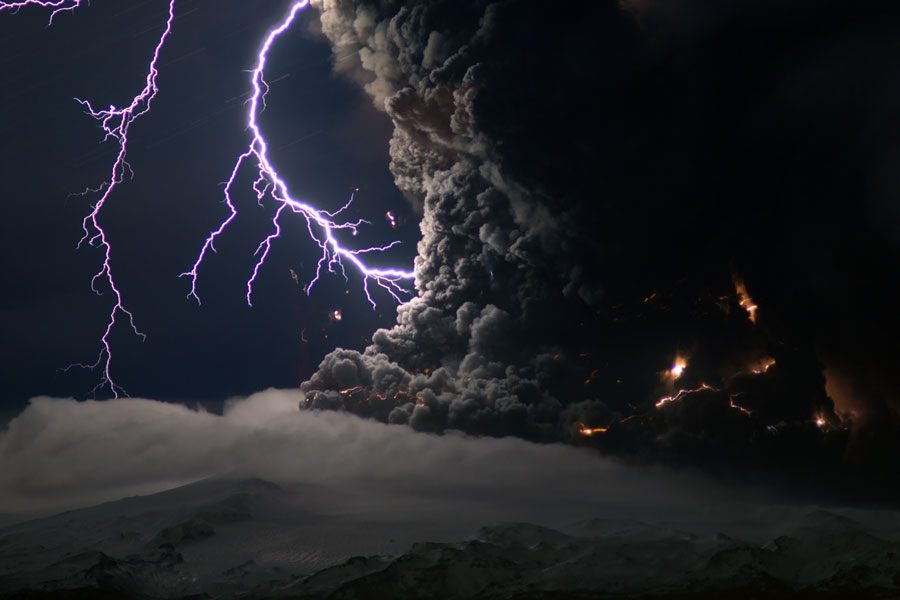
The lightning photographed in Iceland volcano eruption has renewed interest in the source of charge and similarities thereof with lightning we normally observe in thunderstorms. In the updraft of a thunderstorm, moisture is carried upward at high velocity and freezes at about 10,000 m to produce ice particles that rub against those ice particles that after reaching maximal height and now are falling downward to the earth under gravity. The particles are macroscopic, and therefore the atoms in the ice have low frequency thermal kT energy in the FIR.
Nanoparticles (NPs) formed upon rubbing of upward and downward macroscopic ice particles in the updraft are the likely source of charge in thunderstorms . The NPs are submicron and differ from macroscopic particles in that quantum mechanics (QM) precludes the ice atoms in NPs from having kT energy. At the instant of NP formation, the ice atoms therefore have kT energy in excess of that allowed by QM. But QM also requires the specific heat of the ice atoms to vanish, and therefore the excess kT energy cannot be conserved by an increase in temperature. Conservation may only proceed by the quantum electrodynamics (QED) induced up-conversion of the low frequency FIR energy of the atom to the EM confinement frequency of the NP. Since the submicron size of the NP confines the FIR energy of the atoms to high EM frequencies in the UV and beyond, the NP charges positive and emit electrons by the photoelectric effect. With the earth charged positive before the thunderstorm, the free electrons attach to the downward falling particles to the charged earth negative. Accumulation of charge from NPs during the storm produces a large potential difference between the cloud and the earth that upon electrical breakdown creates cloud-to-ground lightning. However, the potential difference may occur within the thundercloud itself as commonly observed in cloud-to-cloud lightning.
The charging process in volcanic lightning is similar to that in thunderstorms except that the NP are produced by the rubbing of macroscopic ash instead of ice particles. Most volcano lightning is observed as in the photograph above by electrical breakdown between the potential differences within the ash plume itself as in cloud-to-cloud lightning of thunderstorms. The source of charge in volcano lightning finds commonality the Unified Theory of Electrification in Natural Processes based on the formation of NPs upon rubbing of surfaces in tribology, and tribochemistry. See Press Release and ScienceBlog

Cosmology by Cosmic Dust - Update
In 1929, Edwin Hubble formulated a law that the velocity of a receding galaxy is proportional to its distance to the earth. This meant that a galaxy moving away from us twice as fast as another galaxy is twice as far away. Hubble based his law on Doppler’s effect whereby the wavelength of light from the galaxy is redshift if the galaxy is moving away from us. Thus, by measuring the redshift of known spectral lines, Hubble claimed to estimate the recession velocity of the galaxy relative to the Earth.
Today, cosmologists take Hubble’s Law as proof the Universe is expanding based on the redshift of supernova light. If, however, there the redshift could be shown to have a non-Doppler origin, the Universe need not be expanding. Hence, redshift without an expanding Universe is of utmost importance because many of the outstanding problems in cosmology would be resolved.
The redshift of light from galaxies and supernovae is shown to occur upon absorption in cosmic dust by the mechanism of QED induced EM radiation. QED stands for quantum electrodynamics and EM for electromagnetic. Scattering is inconsequential. Moreover, QED redshift does not depend on Doppler shift, but rather only on the absorption of a single distant photons in cosmic dust. QED induced redshift may be understood by treating the absorbed photon as EM energy confined within a dust particle having diameter D and refractive index n. Recalling from quantum mechanics that photons of wavelength L may be created by supplying EM energy to a box with walls separated by L/2, the EM energy of the absorbed photon having wavelength L is spontaneously redshift Z = (Lo – L)/L, where Lo = 2nD. See Paper and Presentation
QED induced redshift is caused solely by the absorption of the distant photons in cosmic dust and has nothing to do with an expanding Universe. Hence, any implied relation of dark energy to an expanding Universe is unphysical. Cosmology by cosmic dust holds in question the Hubble redshift as proof the Universe began in the Big Bang suggesting a return to a static Universe in dynamic equilibrium once proposed by Einstein. Other consequences are:
1. Dark Energy need not be discovered to explain an Expanding Universe,
2. Qualification of the Period-Luminosity relation in Cepheid stars,
3. Dark Matter not needed in Gravitational Lensing,
4. Galaxy Rotation Problem resolved without Dark Matter,
5. No need for MOND to explain Galaxy Rotation Problem,
6. Consistent with Tolman Surface Brightness reduction by (1 + Z),
7. Explain the Independence of Redshift in Sunyaev-Zeldovich Effect, and
8. Light Curves in Supernovae Explosions
Olbers Paradox and Cosmic Dust
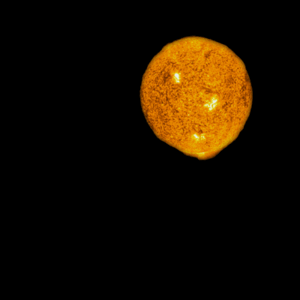
The German astronomer Heinrich Olbers in 1823 is credited with the paradoxical observation that the night sky is dark, but in a static infinite universe the night sky should be bright. Indeed, Olbers paradox is often cited as evidence for the Big Bang theory. In a static infinite Universe, the observer would see a nearby galaxy in one region of the sky and another galaxy in a more distant region. Although the nearer galaxy would appear brighter, there would be more galaxies in the more distant region of the sky. Therefore, the total light from the nearer region of the sky would be the same as that from the more distant region. No matter where the observer looks in the sky, the total light coming from every line-of-sight would be the same. See figure above. Olbers paradox therefore concludes the night sky should contrarily be bright and not dark if the Universe is infinite.
The problem with Big Bang explanation of Olbers paradox is that the Universe is unequivocally not transparent because of ubiquitous submicron cosmic dust, and therefore the distance from which galaxy light can reach the observer is indeed bounded. The second law is not violated, however. In fact, QED induced redshift based on QM allows submicron cosmic dust to redshift visible light to infrared and microwaves regions of the EM spectrum without increasing in temperature. QM stands for quantum mechanics, QED for quantum electrodynamics, and EM for electromagnetic. Therefore, a static infinite Universe without the Big Bang explains Olbers paradox. See Press Release and Scienceblog
QED Induced Heat Transfer

The ECI Conference 2010 on Nanofluids is being held in Montreal. QED induced radiation based on quantum mechanics (QM) is applicable to nanofluids including a wide diversity of applications at the nanoscale. Heat transfer by QM differs significantly from that by classical physics. Statistical mechanics allows the atom to have heat capapcity at the nanoscale, and therefore nanostructures may conserve absorbed EM energy by an increase in temperature. In contrast, QM negates the heat capacity of the atom in nanostrucures and precludes the atom from conserving absorbed EM energy by an increase in temperature. Theory and applications are presented. The final PPT presentation of QED heat transfer for the ECI Conference on Nanofluids is given in Presentation
Colloidal Silver
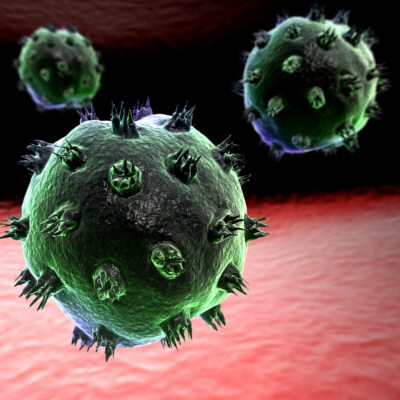
Colloidal silver comprising silver NPs in solution is related to the controversy over the risks of silver NPs in food products. Colloidal silver has been used for fighting infections for thousands of years. But for the last 40 years, silver colloids have been proven to be cancer-causing agents. Indeed, silver is listed in the 1979 Registry of Toxic Effects as causing cancer in animals. Silver finds antibiotic action from the fact that it is a non-selective toxic biocide. Regardless, fine silver NPs provide greater effectiveness than coarse NPs because toxicity is predicated on exposing the infected region to the largest possible surface area.
More recently, the toxicity mechanism of NPs capable of producing ROS was proposed to find origin in quantum mechanics. Toxicity is found to almost be independent of the material, although silver has received the most attention because of its use as a bactericide in baby food. By this theory, atoms in NPs lack specific heat because at ambient temperature the heat capacity in submicron NPs resides at wavelengths < 1 micron may only be populated at temperatures greater than about 6000 K. At ambient temperature, the heat capacity is therefore “frozen out”, and so NPs lack the heat capacity to conserve absorbed EM energy from colliding water molecules in body fluids by an increase in temperature. Conservation may only proceed by the QED induced frequency up-conversion of absorbed EM energy to the EM resonance of the NP. QED stands for quantum electrodynamics and EM for electromagnetic. Typically, ionizing QED radiation is emitted at UV or higher levels thereby producing the reactive oxidative species ROS that damage DNA from which cancer may develop. NPs < 100 nm are required to produce ROS through ionizing radiation. In contrast, NPs > 100 nm emit non-ionizing QED radiation in the VIS and IR.
Recent comments to a Scientific American article stated if the widely touted “natural antibiotic” usage of colloidal silver is a potentially dangerous thing, then: Are there any safe colloidal silvers? Or Are the silver components in such preparations larger than problematic?
Answers to these questions depend on effectiveness. Colloidal silver is perfectly safe if not taken at all, but is not effective if other antibiotic agents are not used. Least effective are silver colloids with coarse NPs > 100 nm because the QED radiation emitted by the NPs in the VIS and IR is non-ionizing. Most effective are fine NPs < 100 nm, but come at the risk of damaging the DNA by UV or higher ionizing radiation that can lead to cancer. See Press Release and ScienceBlog
Cancer by Epithelial Tissue Disorganization
Cancer research is only beginning to recognize the remarkable fact that submicron entities present in body fluids emit low-level ionizing radiation. Over the past few decades, this fact has been supported by experimental evidence that shows submicron entities comprising nanoparticles (NPs) of natural and man-made materials in body fluids cause DNA damage.
Indeed, biolgical NPs like the inanimate NPs may also produce ionizing radiation. Epithelial tissue forming the outer layers of the skin protect exterior surface of the body, but also provide a protection for hollow organs and glands including the breast, prostate, colon, and lung from body fluids. Epithelial tissue is organized by a submicron thick < 100 nm basement membrane (BM) that provides the structural scaffold template for the extracellular matrix (ECM). Breakdown of the BM is associated with the spread of tumors, e.g., loss of integrity of the BM in mice is known to cause tumors. Loss of integrity in the ECM is triggered by enzymes called matrix metalloproteinases (MMPs). Breast tumors in particular are known to have an increased amount of MMPs. Indeed, MMPs induce the epithelial-mesenchymal transition (EMT) that disorganize the BM and allows the dissociated epithelial tissue to move through the body. In breast cancer, EMT allows tumor cells more mobility to penetrate barriers like the walls of lymph and blood vessels, facilitating metastasis, e.g., the MMP-3 enzyme causes normal cells to produce a protein called Rac1b that is found only in cancers. See Cancer comes full circle
Epithelial tissue like NPs produce QED induced ionizing radiation from the < 100 nm BM upon disorganization of epithelial tissue by MMPs.By the theory of QED induced radiations, the disorganization of the BM by MMP-3 produces the ionizing radiation that forms the ROS that in turn damage the DNA. See Press Release and ScienceBlog.
Anomalous High Thermal Conductivity of Thin Films
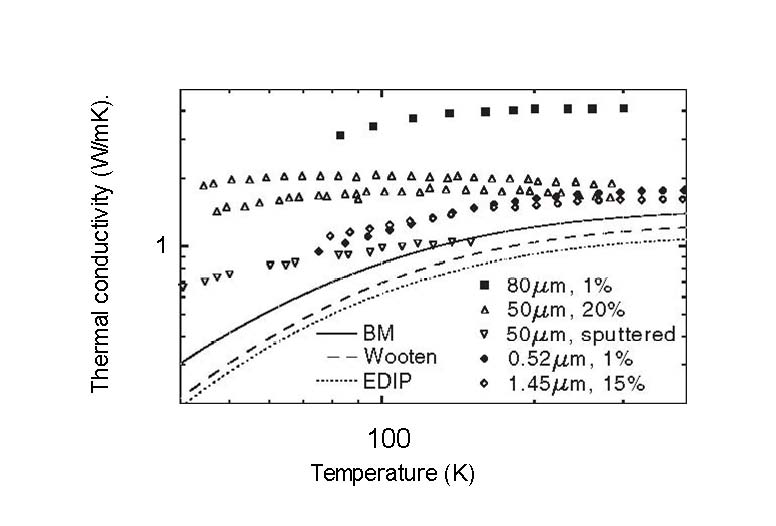
Thermoreflectance measurements at room temperature for an 80 micron a-Si sample show at more than a 2-fold increase in thermal conductivity compared to submicron samples having thicknesses of 200 nm and between 1 and 2 microns. See CDAC Graph, Paper, and Press Release. On this basis, it was concluded: (1) phonons with a mean free path of ~ 100 nm make a sizeable contribution to conductivity, (2) size in terms of the sample thickness was not expected to make a significant difference in measured conductivity for the 80 micron and 200 nm samples, and (3) current theoretical methods cannot account for the nearly 40 percent contribution from phonons with a mean free path between 100 to 600 nm as inferred from the TDTR measurements.
However, QED induced EM radiation avoids phonons and promptly creates photons within the nanostructure that then are emitted to the surroundings as non-thermal QED radiation at UV or higher levels. What makes this possible is that quantum mechanics requires the specific heat of atoms at the nanoscale to vanish. See “Nanofluids and Thin Films”, 2009 and "QED Induced Heat Transfer", 2010 including Press Release and ScienceBlog. Commennts on the CDAC conclusions are:
Conclusion (2) that size in terms of sample thicknes is not expected to make a significant difference in conductivity is questionable because of the size effect of quantum mechanics.
Conclusion (1) that phonons with a mean free path of ~ 100 nm make a sizeable contribution to conductivity not only contradict (3) that current theoretical methods based on phonons cannot explain the higher conductivity of the 80 micron sample, but both are meaningless because there is no conductive heat flow at the nanoscale.
Lindau Nobel Meeting on Cosmology
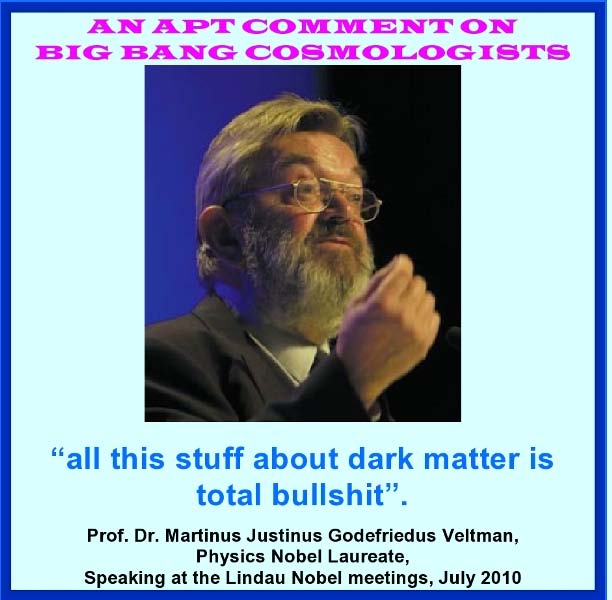
The Large Hadron Collider (LHC) is of interest to astronomers because elementary particles are thought related to dark matter and energy in the expanding Universe of Big Bang cosmology. Indeed, the recent Lindau Meeting discussed the topic "Dark Matter, Dark Energy, and the LHC.” Scientists George Smoot and John Mather who won the Nobel prize for the Cosmic Background Explorer (COBE) were joined by physicists David Gross, Carlo Rubbia, Gerard t'Hooft, and Martinus Veltman. Consistent with the theme of the Lindau Meeting on cosmology, Nobel Laureate George Smoot stated:
“The properties of the tiniest particles should dictate what the Universe looks like…”
With regard to dark matter, Smoot himself did not follow through by describing the mechanism by which tiny particles dictate what the Universe looks like, yet claimed cosmologists can model the Universe with gas, photons, and neutrinos giving a Universe of mostly dark matter of which only about 27 percent is visible while dark energy is expanding the Universe at an accelerated rate. Similarly, Mather avoided the tiny particles and instead talked about the presence of dark matter inferred from gravitational lensing measurement. However, Veltman pictured above called dark matter "bullsh*t," but then like Smoot and Mather did not identify the mechanism of how tiny particles dictate the Universe what we see.
Cosmology is only beginning to recognize that redshift in submicron cosmic dust significantly alters how the Universe looks to us. See above “Cosmology by Cosmic Dusts.” In fact, redshift in cosmic instead of by the Doppler effect allows one to entertain the cosmology of a static Universe without any need to find the elusive dark matter and energy. Given that our knowledge of the Universe by seeing galaxy light is unequivocally altered by absorption in cosmic dust, Smoot’s comments may be rephrased by:
”The properties of cosmic dust should dictate what the Universe looks like…”
The Lindau Nobel Meeting on cosmology by elementary particles is trumped by cosmic dust. There is no connection between any findings forthcoming from the LHC on how WIMPS or other exotic particles are related to dark matter. Smoot’s comment on how tiny particles dictate what the Universe looks like was misinterpreted by all of the attendees because none considered the tiny particles to be submicron cosmic dust. Hubble’s redshift by the Doppler Effect held for 80 years needs to be set aside and superseded by QED induced redshift in cosmic dust, an unpleasant, but necessary action by astronomers if cosmology is to move forward. See Press Release and Science Blog
Chris Beling - a rose in a bed of thorns
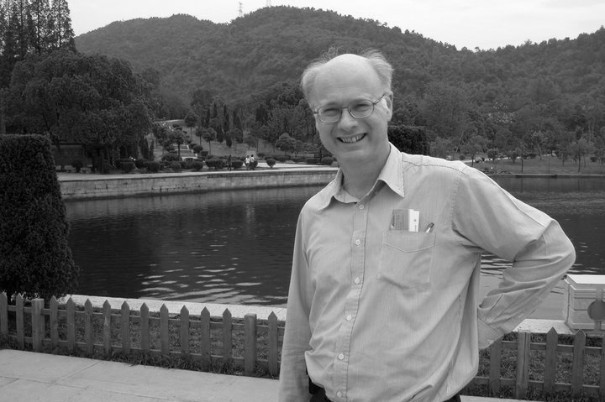
Upon recently returning to Hong Kong, I was shocked to hear of the death of Chris Beling, an Associate Professor in Physics at the University of Hong Kong (HKU). While in England, Chris died in a drowning accident trying to save his brother.
Chris was a Creationist, although I am not. Nevertheless, we discussed physics as friends – in particular - sonoluminescence (SL) or the conversion of sound into light in collapsing bubbles. But the accepted SL theory was that collapsing bubbles in water produced light from high temperatures which was to me untenable. With an open mind, Chris let me run some solid state SL experiments in his laboratory to test other SL theories. Chris knew that science is not cast forever in an unchanging mold and other explanations of the SL light are possible.
Yet Chris was the first to admit that my search for the truth of the SL light would make enemies of other HKU faculty who in their mediocrity cannot have an open mind. Indeed, anytime one searches for truth, one has many enemies. Ironically, Chris would experience a similar fate because his Creationist belief clashed with the status quo Evolutionist on the HKU science faculty. See Press Release
The Nose and Smell

Olfaction by shape and vibration mechanisms that claim to explain smell has a long history of controversy. The olfaction shape mechanism was formulated in 1949 based on Linus Pauling's notion of shape-based molecular interactions. The shape mechanism superseded the vibration theory of olfaction and today remains the mainstream theory, The vibration mechanism was first proposed in 1937 after which it was largely abandoned in favor of the competing shape theory. A 1996 paper by Luca Turin revived the theory by proposing a mechanism, speculating that the G-protein-coupled receptors actually measure molecular vibrations using inelastic electron tunneling, The long-standing controversy is embodied in the question:
What signal of an odorant molecule do the G-protein receptors in our noses pick up?
Odorant molecules may be considered small NPs. But a molecule does not have a TIR resonance – only vibration resonances represented by its IR spectra. Nevertheless, QED radiation like a laser excites the odorant molecule to emit its unique IR spectra. Prior to collision, the temperature of the odorant molecule in the ambient air is 20 C while the nose is at body temperature of about 37 C. The odorant molecule therefore absorbs thermal kT energy upon collision with the inside of the nose. Upon leaving or breaking contact with the nose surface, the odorant molecule by QM cannot conserve the absorbed kT energy by an increase in temperature, and therefore the absorbed EM energy is conserved by the emission of non-thermal QED induced radiation.
QED radiaion excites the odorant molecule to emit its IR spectra. However, enantomers having identical IR spectra cannot be distinguished by IR spectra alone. Enantiomers are unique in that they have different vibrational circular dichroism (VCD) spectra that rotated in opposite directions with otherwise identical magnitude and frequency. Regardless, QED induced radiation like a laser excites boith IR and VCD spectra. The odorant molecule by emitting its IR and VCD spectra therefore signals the G-protein of its unique presence inside the nose. See Press Release
Nanoparticle Toxicity and Cancer
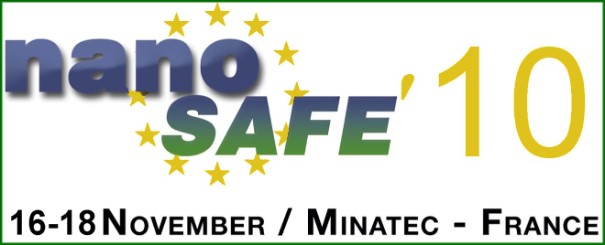
NPs have provided significant advancements in cancer treatment. Today, photodynamic therapy using NIR lasers is common place, the necrosis of the tumor thought caused by high temperatures from the heating of attached NPs. However, NPs have a darkside. Even without NIR lasers, experiments have shown NPs alone in body fluids pose a health risk by inducing DNA damage that in of itself may lead to cancer. NPs unable to discriminate between the cancer cell and the DNA therefore act as a double-edged sword. To avoid the dilemma that NPs are toxic to cancer cells and
But what is the toxicity mechanism of NPs?
Currently, this question is unanswered. Surface effects are generally thought to provide the toxicity to explain observed bactericidal action of NPs, but lack the Planck energies necessary to damage the
What is the source of EM radiations in body fluids?
Certainly, there are no UV lasers in body fluids. Nevertheless, experiments show
QED induced EM radiation provides NPs with a remarkable source of toxic UV or higher ionizing low level EM radiation to enable NPs to function in cancer necrosis while at the same time may also damage the
PCs and Graphene

The 2010 Nobel Prize was awarded for the discovery of graphene - a single monolayer of carbon atoms. But in June 2010 at the ITHERM Conference, graphene was already being promoted as a material with high thermal conductivity that will spread the heat from power dissipation sources in PCs. Paper1 Compared to suspended graphene, phonon scattering was thought to explain the reduced conductivity of graphene on a silicon dioxide substrate. Paper2 Indeed, phonon scattering was thought to be the first step in providing the analytical basis to prove the optimum conductivity of graphene for PC's. Paper3
However, the superior thermal conductivity of graphene for PC's may be overstated.
PC power dissipation does not depend solely on the thermal conductivity of graphene or any other material such as copper because natural convection controls the overall heat transfer. Even if graphene had an infinite conductivity, natural convection would still limit heat dissipation.
But QED radiation may actually prove that graphene or any submicron copper film is the optiimum PC material. QED radiation bypasses natural convection and transfers PC heat as non-thermal radiation into the surrounding air. Submicron thin films are superior to thick films because the QED radiation having UV or higher frequencies can penetrate and deposit the PC heat deep into the air suroundings.
Moreover, reduced thermal conductivity of graphene on a substrate is not real, but rather an artifact of BTE and phonon theory. Indeed, QED induced heat transfer asserts the conductivity of suspended and supported graphene remains at bulk because heat dissipation occurs soley by the prompt emission of QED photons with inconsequential heat transfer by phonons. QED induced heat transfer governs the thermal management of PCs at the nanoscale, i.e., graphene dissipates heat by QED emission because photons respond far faster than phonons. See Press Release
Specific Heat in Nanostructures

The Theta 3 Conference on Thermal Issues in Emerging Technologies is held in Cairo. Of special interest are thermal issues of QED induced radiation at the nanoscale. Specific heat in nanostructures is a common theme of QED induced EM Radiation and follows that described in " Zero Specific Heat", 2010. In solid nanostrucutres, the QED radiation is emittted at the TIR resonance. For NPs of diameter D, almost all of the absorbed EM energy is converted to TIR because of the the high surace to volume ratio at the nanoscale. However, with regard to the sense of smell caused by odorant molecules that collide with the surface of the nose , TIR emission is meaningless. In such applications, the QED induced EM radiation from odorant molecules is converted to the EM spectrum of the molecule thereby allowing prompt detection by the G-protein receptors in the surface of the nose. See Paper and Presentation